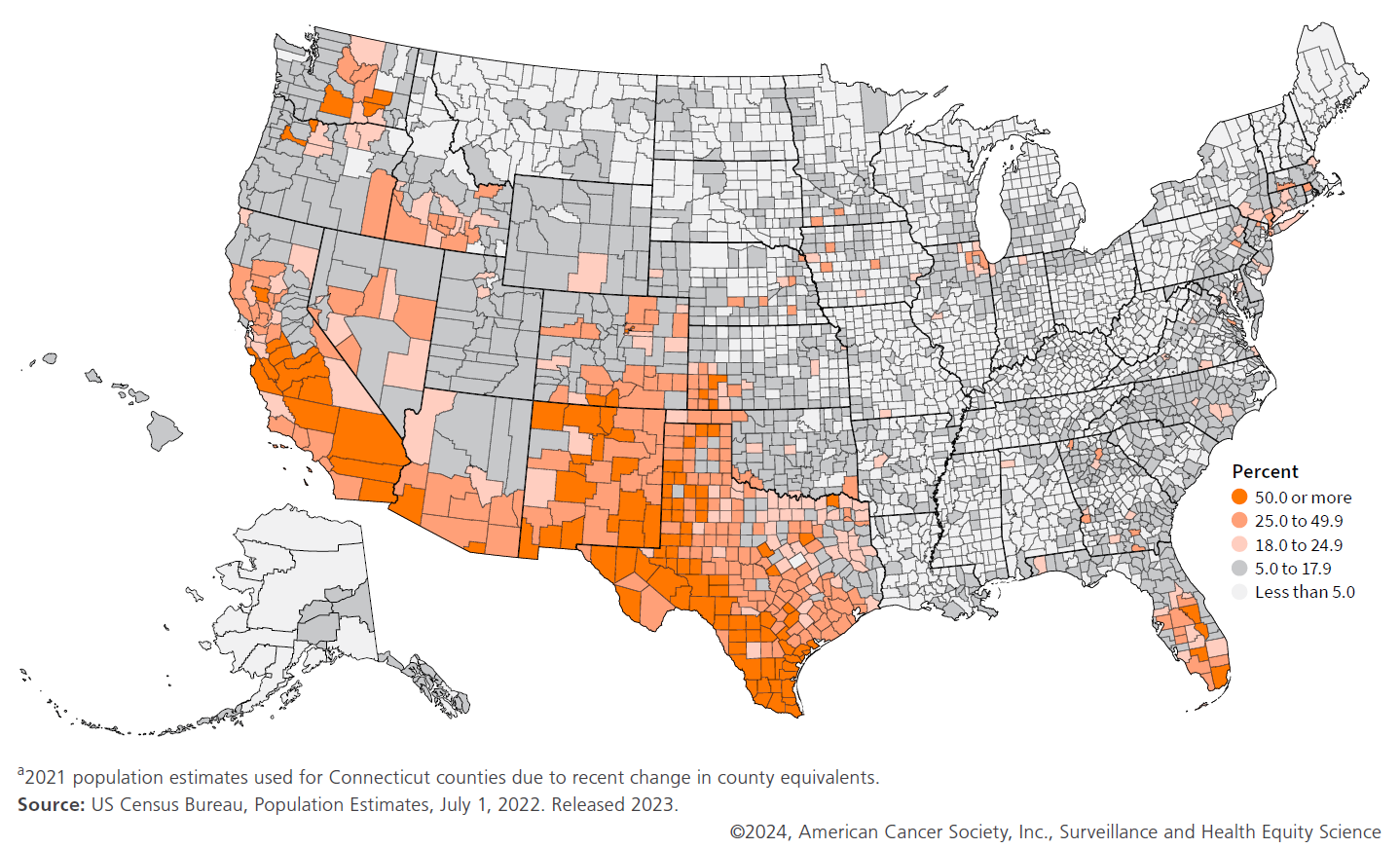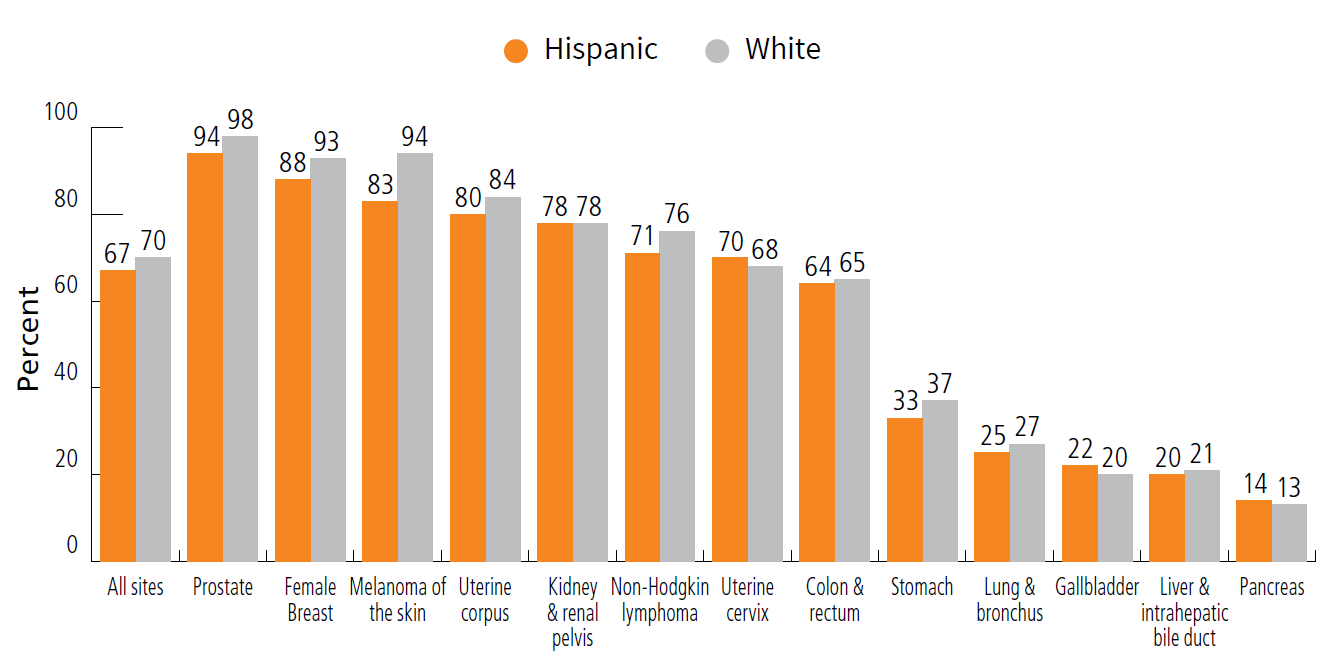Cancer Care Lags for Hispanic People in the US
New report finds that obstacles to care decrease cancer screening, early-detection, and survival rates for Hispanic people in the US compared to White people.

This map of the United States shows the countries where Hispanic populations live in each state. Dark-orange counties signify that 50% or more of the local residents are Hispanic. As the density of the dark-orange countries shows, the majority of Hispanic people live in 3 states in the Southwest—California, New Mexico, and Texas.
A new report from the American Cancer Society (ACS) details the rates of new cancer cases and the rates of cancer deaths among Hispanic/Latino people in the United States. Differences in cancer occurrence and outcomes among Hispanic populations largely result from obstacles to health care access, which include structural racism, a higher likelihood of poverty, and language barriers.
The report is published in Cancer Facts & Figures for Hispanic/Latino People 2024-2026. Its intent is to inform community leaders, public health and health care workers, cancer control advocates, and others interested in cancer prevention, early detection, and treatment for Hispanic people.
Glossary for Nonscientists
Featured Term:
Structural Racism/Systemic racism
Normalized historical, cultural, political, and institutional practices that govern society and benefit White people and disadvantage people of color. These can include housing policies, educational systems, and employment practices that reinforce and perpetuate inequities among racial groups.
Hispanic people are the second largest and youngest racial/ethnic group in the US—making up about 19% of the total population. The majority (59%) of Hispanic people in the US identify as Mexican, followed by Puerto Rican, Salvadoran, Cuban, and Dominican. Cancer data is only available for Hispanic people in aggregate, not by ethnic group.
Most differences in the occurrence of cancer between populations are due to the prevalence of risk factors (like smoking and eating an unhealthy diet, as well as exposure to infectious agents) and access to quality health care—not biology. For example, Hispanic men born in the US have an overall death rate from cancer that is 15% higher than those born outside the US because they’ve adopted unhealthy behaviors that increase their risk of developing cancer.
Sociodemographic factors such as a limited education and poverty, may influence a person’s exposure to risk factors and access to preventive care, such as screening for early cancer detection, and treatment. In the US, about 17% of Hispanic people live in poverty compared to 9% of White people.
Proven strategies for reducing the cancer burden in Hispanic people include using culturally appropriate lay health advisors and patient navigators in combination with targeted community-based intervention programs to facilitate access to screening and promote healthy behaviors.”

Here are some key issues and findings from the report.
Health insurance disparities
Percentage of uninsured adults ages 18 to 64:
- Hispanic people: 28%
- White people: 8%
Having or lacking health insurance affects cancer screening rates and rates for finding cancer at an early stage, when treatment is more likely to be successful.
Cancer screening disparities
Cancer screening saves lives. Screenings for cervical cancer and colorectal cancer has the potential to prevent those cancers completely. Certain tests for these two cancers can allow doctors to spot cells that are abnormal and remove them before they become cancerous. Mammography for breast cancer helps find it early, when it is typically easier to treat, but it’s not a preventative tool.
Hispanic adults are less likely to receive screening than White adults.
Cervical cancer screening rate disparities
Percentage of women who get screened for cervical cancer based on the guidelines:
- Hispanic women: 69%
- White women: 80%
Colorectal cancer screening rate disparities
Percentage of people who get screened for colorectal cancer based on the guidelines:
- Hispanic people: 52%
- White people: 65%
Breast cancer screening rate disparities
Percentage of women who get screened for breast cancer based on the guidelines:
- Hispanic people: 60%
- White people: 65%
Prostate cancer screening rate for men ages 50 and over
Percentage of men who get screened for prostate cancer based on the guidelines:
- Hispanic men: 28%
- White men: 38%
Stage at diagnosis disparities
The best-case scenario is to find cancer at an earlier stage. At that point, the tumor is typically smaller and has not spread far from its starting point, so treatment may be less complex and more successful. A late-stage diagnosis, when the cancer is larger and likely has spread far from where it started, may affect survival rates.
“Hispanic people are less likely to be diagnosed with an early-stage cancer, in part because of lower screening rates,” says Siegel.
Percentage of adults diagnosed with an early (localized) stage cancer overall:
- Hispanic people: 42%
- White people: 46%
Melanoma
The largest disparity for early detection is for the percentage of people diagnosed with melanoma at an early stage:
- Hispanic people: 65%
- White people: 78%
Breast cancer in women
Percentage of women diagnosed with an early (localized) stage cancer:
- Hispanic women: 60%
- White women: 68%
Prostate cancer
Recent changes in prostate cancer guidelines about when a man should have a PSA test may be at least partly responsible for fewer Hispanic men learning they have prostate cancer when it’s still potentially curable.
- Hispanic men: 64%
- White men: 71%
Incidence in childhood leukemia disparities
The occurrence of lymphoid leukemia and other types of leukemia is higher in Hispanic children and adolescents than in any other racial group. Black children and teens have the lowest rates.
- Hispanic kids: 59 cases for every 1 million people
- Black kids: 30 cases for every 1 million people
That's nearly a 2 times higher incidence rate of lymphoid leukemia for Hispanic kids.
Exposure to infectious diseases for Hispanic people
Some cancers are caused by bacterial or viral infections.
Stomach cancer
Largely caused by the bacteria H pylori, stomach cancer incidence rates are:
- Hispanic women: 8 cases for every 100,000 people
- White women: 4 cases for every 100,000 people
That means Hispanic women have about double the risk of developing stomach cancer compared with White women. Hispanic men have a higher risk too, but the difference compared to White men is smaller.
Liver cancer
About half of liver cancer diagnoses in the US are caused by hepatitis B virus (HBV) or hepatitis C virus (HCV). There is a vaccine to prevent HBV that the CDC recommends for all children and adults up to age 59. There is no vaccination for HCV.
The risk of developing liver cancer is nearly double for Hispanic men and women compared to White men and women.
Cervical cancer
Caused by exposure to HPV (human papilloma virus), cervical cancer incidence rates are:
- Hispanic women: 10 cases for every 100,000 people
- White women: 7 cases for every 100,000 people
That’s a 36% higher incidence rate.
HPV vaccination
HPV immunization for girls and young women and screening with HPV tests and Pap tests for women make cervical cancer largely preventable.
Cervical cancer prevention
Complete course of HPV vaccinations for 13- to 17-year-olds.
- Hispanic teens: 65% were up to date
- White teens: 60% were up to date
5-year relative survival rate disparities
Lower survival rates may reflect a later-stage diagnosis, more aggressive disease, and barriers to care, such as lacking health insurance, public transportation, paid time off from work, and so forth.
Five-year survival rates in Hispanic people are also lower for breast and prostate cancer, in part reflecting later-stage diagnosis.
Glossary for Nonscientists
Featured term:
5-year relative cancer survival rate
A comparison of the survival of a group of people with cancer to the survival of a group of people in the general population. Relative survival rates are calculated by dividing the percentage of people with the same type and stage of cancer who are alive at least 5 years after diagnosis by the percentage of people in the general population who are alive after 5-years.

The first bars in this graph (All sites), shows that when all cancer types are considered together, the 5-year survival rate for Hispanic people is only slightly lower than for White people (67% versus 70%). The largest difference for 5-year relative survival rates is for melanoma of the skin, with 83% of Hispanic people alive at least 5 years after diagnosis compared to 94% of White people.
American Cancer Society news stories are copyrighted material and are not intended to be used as press releases. For reprint requests, please see our Content Usage Policy.




